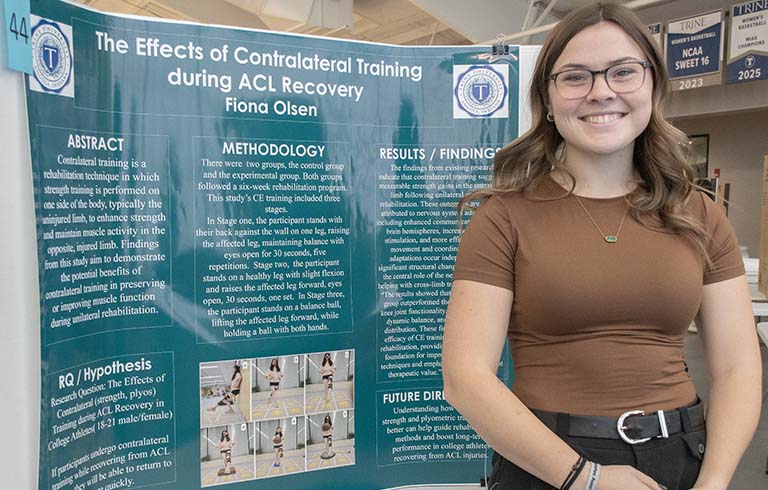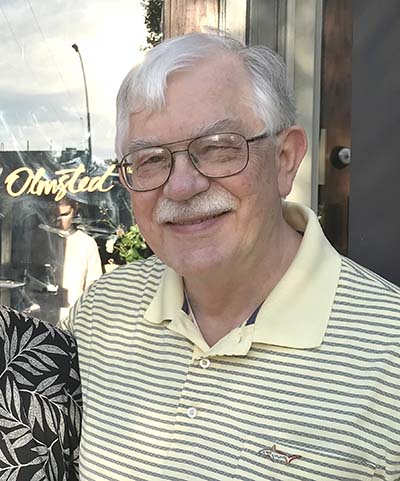
Students honored at Trine’s STEM Symposium
Trine University students have been honored for projects presented at the university’s ninth annual STEM Research and Design Symposium, held Thursday, Dec. 4, on the concourse of the MTI Center.
June 06, 2024
By Ian Hoffman
Communication ‘26
 To say Al Lemke, a 1960 mechanical engineering graduate of then Tri-State University,
had a different path to success would be an understatement.
To say Al Lemke, a 1960 mechanical engineering graduate of then Tri-State University,
had a different path to success would be an understatement.
He is originally from Latvia, but he and his family emigrated to the United States from Germany in 1951 to pursue the American dream and to escape a still-recovering Europe after World War II. He spent his teen years in Huntington, Indiana, just south of Fort Wayne.
From a young age, Al loved to build. He would build erector sets and his own designs from the metal parts.
As he got older, he started to build and fly model airplanes, many of which he would design himself. He also enjoyed his school’s vocational classes, and took a class in drafting, a precursor to the CAD software we have today. He would also work as a junior draftsman during a summer in high school for a brake shoe factory.
Coming to Tri-State
Al chose Tri-State for several reasons. First, it was close to his hometown of Huntington. Second, at the time, the year was divided into four quarters, which allowed a degree to be completed faster. Third, he wanted a school where engineering was a focal point, which has remained true to this day. Finally, he understood Tri-State would provide a quality education for him like it had for his older brother Eugene, who graduated with a degree in electrical engineering in the late 1950s.
After graduating, Al began looking for a job. Like many of his classmates, he had some interest in working for big name manufacturers, including General Motors, Ford and Caterpillar.
However, he became interested in an, at the time, smaller tech company in New York called IBM. He noted that IBM “kind of lacked macho charm,” specifically the punched cards, one of IBM’s earliest inventions. At the very least, he thought, it was a “free trip to New York.”
It would be a trip that would have major ramifications and an impact on Al’s life forever.
Further education through Big Blue
Al’s biggest interest in IBM was their interest in him, specifically his desire to pursue additional education. Until his interview with IBM, no company had been willing to let him take the leave required to obtain his MSME. He had already applied and been accepted to Michigan State and the Massachusetts Institute of Technology, better known as MIT.
He would go on to obtain his MSME from MIT in January 1962, and had a fellowship there that was sponsored by the US Department of Defense and covered most of his expenses.
Upon his return to IBM, he worked in the Research Division to develop optical storage for electronic language translation. He would then move into researching automatic optical artwork generators for making semiconductor optical lithography masks. After five years in Research, he was promoted and worked on a host of different projects.
Al was part of some major developments in IBM and computer history. He was one of the original developers for machines’ direct step and repeat pattern exposure on semiconductor wafers, which was on the leading edge of what anyone was doing in the computer space at that time. These products, better known as “steppers” today, are considered a product of national security importance that some countries are not allowed to purchase.
He would also work on the development of production optical inspection equipment and the management of manufacturing process control and factory product flow information system, which would help set the base for much of the automation used today.
For his final eight years with the company, Al was promoted once more to help coordinate the research and development of multiple locations within IBM and with companies they partnered with.
This allowed for one of his most enjoyable parts of his career. His boss at the time, Rao Tummal, asked him to present at Carnegie Mellon University in New York City in his place.
This provided a unique opportunity to Al. He noted that he was nervous for the first couple of minutes in his presentation, but once he got started, he felt right at home. He was also able to present his own findings, which looked at consumer, computer and communication technologies merging as he thought the world would become increasingly digital.
As it turned out, he was right, and he was asked to present his findings at various locations and to different organizations, including Rensselaer Polytechnic Institute (RPI), IBM La Hulpe in Belgium, NATO, Oxford University in the UK, and all of the IBM development locations in the United States.
In total, Al spent 26 years at IBM as an engineer, and the remaining time working in management and presenting his findings, for a total of 33 . During that time, he saw technology change in “revolutionary” amounts. This allowed him to always have something new to learn and coincided with an ever-changing job and work environment.
After IBM
For many people, 33 years would be enough to call it a career. But Al is not most people and started working for Cejay Engineering as a consultant.
Cejay Engineering was founded in 1985 to provide personal illumination tools for use with night vision equipment. Derek Hanes, one of the founders of Cejay, worked with Al for a period at IBM. When Al decided to leave IBM, Hanes jumped at the opportunity to have him on his team.
Al has since transitioned into the leader of anything technical Cejay does. He worked with mechanical design, molding design, electronic circuit design, microcontroller implementation, firmware development and manufacturing release. He has designed or managed the design for nearly every project or product sold by Cejay that has some type of electronic component.
He continues to work for Cejay, meaning he has spent well over 60 years in the tech industry, almost exclusively working as an engineer.
Working for Cejay has been an incredibly enjoyable experience for Al. Despite his home being in New York, he has been able to work remotely for the Sarasota, Florida-based company – thanks in no small part to his findings and predictions at IBM on how we would communicate in the future. He started as an employee but describes his relationship with Hanes and others at Cejay as familial.
Al has no plans on retiring anytime soon, describing it as “totally overrated.” As long as he enjoys his job, he will happily continue to work.
He has seen the technology world change rapidly over his 64-year career and has enjoyed being on the leading edge. When asked about what it was like to be on the leading edge of so many technologies for so many years, he compared it to a dog sled team.
“[If] you make the advancements, you’re the leader. Others do it, you are a follower, like the second dog of a dog sled team that never gets a fresh view,” he said.
It is safe to say Al has been the lead dog for most of his career and will continue to work on being in the lead as he finishes his career.